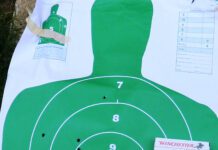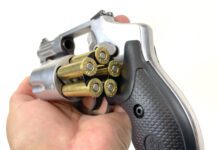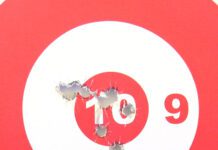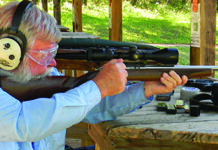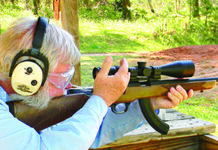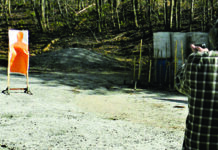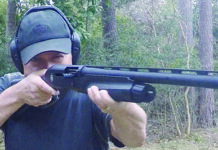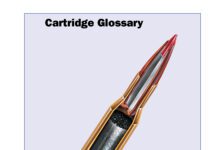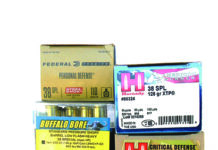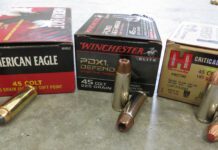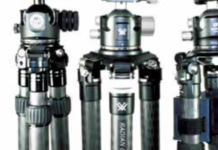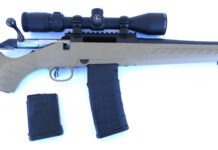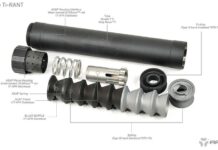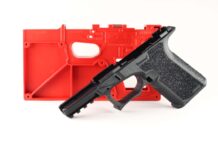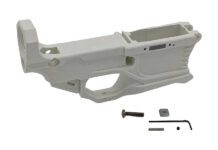Bigger 9mms Handguns: SIG, Arsenal, and Beretta Go At It
As noted earlier in this issue, 9mm auto-loading pistols are among the most commonly purchased firearms in America for pleasure, competition, and defense. These guns are offered in many styles and price points, ranging from a few hundred to several thousands of dollars. While the handguns in this comparison are not top-end, highly customized pistols costing thousands of dollars, they are generally marketed as being well above average quality in fit, features, and capabilities.
In this comparison, we test five pistols, three of which were built by SIG Sauer, one by Beretta, and one newcomer from Arsenal. The SIGs tested are the classic P210, the P226 MK25 used by the U.S. Navy SEALS, and the relatively new P320. The Beretta tested is the recently updated M9A3. The fifth gun is the new Strike One from Arsenal.
For our evaluation, we used three different 9mm loads from three different manufacturers in two different weights and two different bullet styles. As always, the guns in question were shot by multiple testers (this time three men and three women) of different backgrounds.
We did our accuracy testing at Boyert Shooting Centers, an indoor range in Houston, and followed the standard accuracy protocol of collecting five 5-round groups at 25 yards from a rest for each pistol/ammunition combination. For this test, we also performed a speed drill. The speed drill involved starting from a low-ready position, shooting twice to the chest and once to the head of a silhouette paper target. This test was performed at 7 yards by one experienced tester with large hands. The speed test was performed after the familiarization shooting, but before the accuracy testing. The tester was given only one opportunity to perform the test. As these pistols are supposed to be superior to the average offering, our team expected above-average results and graded accordingly. Though all five pistols turned in good results and had their fans, the testing yielded one clear surprise winner.
Selecting Magazines Is Tough
Thanks for the evaluation of 1911 mags. It was quite comprehensive and good information, as usual. I own five 45 Commanders and two Government models, and I have settled on the Colt 8-round magazines as a standard for all. I picked those primarily because of the flush base. I love having nine rounds in the carry gun, but I don't like an extra quarter inch or so extending beyond the grip. Previously, I used Wilson Combat mags because all the guys coming through my classes that shot Kimbers said they had to use Wilson mags with them to make them work reliably. Funny, huh? I never thought of a drop test. I did drop a couple of my Colt mags yesterday and nothing popped out. By the way, I'm using the Ruger/Polycase ARX rounds, and so far I have had no feeding issues except one in the S&W 1911 SCE Commander. The most expensive 1911 I've got, and it's the one that sometimes hiccups.
Hunter Quacks Over A300 Grade
I have seen and done much, but I am still amazed at how many people praise "pocket pistols" over a more substantial weapon. I have carried for about 60 years (yes, I carried when I was 11) and have used virtually every caliber. As I got older, I have gone from the 45 ACP to a Ruger SR9C in, of course, 9mm for a multitude of age-related reasons, but still consider being armed a responsibility to my family. Using the extended magazine, I am comfortable having that 16 rounds plus two spares in a custom Rick Harvey mag carrier (with the bonus of a flashlight between the mags). At 6'5" and 185 pounds, this is easy to carry (24/7/365) and conceal. During the several events whereupon it was necessary to draw my weapon (in the past four years), I never felt undergunned, but I would have felt that with just the Ruger LCP in my ankle holster. People need to face reality; real life usually dictates you need more than the rounds available in a pocket pistol. And yes, I am old and grumpy.
Home-Defense Shotguns: We Compare Three Pump Actions
The shotgun is seen by many as the best choice for personal defense and especially home defense. The most powerful portable shoulder-fired weapon used for self preservation, the 12-gauge shotgun offers a multiple-projectile load that has been proven effective in close-quarters defense. With slug loads, it is even suitable for defense against large, dangerous animals. In rural defense, there are plenty of deadly predators in the country, feral dogs, mountain lions, and other dangerous animals that only an aggressive counterattack will stop. But without proper firearm and load selection, as well as training, the shotgun will be underutilized. More than one citizen has defended himself with the shotgun, and common sense tells us that we should have one in the home.
In this test, the shotguns we chose are among the best in their price range. The choices range from a pedestrian bead-sighted model to a tactical model with an AR-15 type stock. While self-loaders rule the day at 3 Gun competitions and are very reliable, a dirty pump will work when a dirty automatic will not. We have seen self-loaders malfunction during our test programs, and we know the pump-action shotgun is relatively easy to master, as long as you get quality training so you're confident in your skills and sure in your manipulation.
With this in mind, we chose three likely shotguns for home defense. The top end of the budget was $450, but we would prefer to spend less to get a good pump-action gun, if we could. We fired them with practice loads, home defense loads, good loads suitable for pest and predators, and slugs suitable for defense against large animals. We used five different loads for testing these shotguns. We tried to find the most economical offerings in bulk. This included the Fiocchi 12HV75 birdshot ($97 for 250 shotshells from CheaperThanDirt.com) Fiocchi 1-ounce Aero slugs ($8.10/10 from VenturaMunitions.com), Hornady 86240 Critical Defense 00 buckshot loads ($11.08/10 from CheaperThanDirt.com), Hornady's Varmint Express, a load using 24 pellets at 1350 fps ($16/10 from Gandermountain.com), and Winchester 3-inch 12-gauge 00 buckshot loads (No. XB12300VB, $17/15 from CheaperThanDirt.com) This selection covered the likely uses for personal defense, predators, and even large animals. Each shotgun was fired with 50 birdshot shells, 10 of each of the buckshot loads, and 10 Fiocchi slugs, for a total of at least 90 shells per gun. This is punishing work and was not accomplished in a single range session. We fired mainly the light-kicking birdshot to learn how to function the guns quickly and determine their smoothness and ergonomics.
Here are the results.
Big-Bore Snubnoses Around $500: Charter Arms and Taurus
We recently reviewed three 38 Special revolvers that cost about $400 and thought we would increase our budget and caliber size, and then sourced three revolvers each costing about $500 in three different big-bore calibers: 44 Special, 45 ACP, and 45 Colt, often called 45 Long Colt (LC) to ensure it's not mixed up with the Auto Colt cartridge. The three revolvers included two Charter Arms products, the Classic Bulldog in 44 Special and the newer Pitbull in 45 ACP, plus the Taurus Public Defender Polymer chambered in .410 shotshell and 45 LC.
Even though these were new revolvers, we still performed a range-rod test since there was a bit of side-to-side wiggle in the cylinders of all the revolvers. Range rods check the alignment of the chambers to the barrel bore. We also noted that the action of the Taurus seemed a bit stiff; our initial dry firing in double action found the cylinder would not fully index to the next chamber at times. Dry firing took care of the indexing issue, and all passed the range rod test. We also noted during the range-rod test the barrel of the Pitbull was not fully screwed into the frame. It was off by a fraction of a turn, enough to cock the front sight to the left when aiming the revolver. It is unacceptable that a gun leaves the factory in this condition. We anticipated and needed to use Kentucky windage with the Pitbull at the range.
In the past Charter Arms revolvers have been favorably rated, but in these two examples we found exception. The not-fully-screwed-down barrel was also the reason the cylinder-to-barrel gap was so large. We measured the gap between the front of the cylinder and the forcing cone at the rear of the barrel using feeler gauges from Brownells (606-950-252WB) and found a gap of 0.010 inches for the Pitbull and the Bulldog Classic and the Taurus at 0.005 inch. A gap of 0.003 inches is desirable for a competition revolver, but up to 0.006 inches is often found. A large gap allows more gas to escape, reducing the bullet's velocity. It also means there is more flash, and if the chamber and cylinder are not perfectly aligned, a user might experience splash from burning powders and bits of shaved bullet metal. We did not experience any splash with the Charter Arms revolvers. We did note that the Classic Bulldog had about 30 fps more than the published data for Hornady Critical Defense165-grain FTX bullet, which is 900 fps out of 2.5-inch barrel. The 3-inch barrel of Bulldog must have helped increase velocity. The Pitbull had noticeably less muzzle velocity compared to factory data. We assumed the reduction came because the Pitbull has a 2.5-inch barrel and the factory data for the cartridges use either a 4- or 5-inch barrel. Reduced muzzle velocity also occurred in the Taurus.
A common feature of all three revolvers was a safety transfer bar. This system prevents the hammer from striking the firing pin unless the trigger is pulled fully to the rear.
These revolvers are made for close-in work, but we still tested accuracy out to 25 yards. Since the Taurus offers the ability to fire .410 shotshells as well as cartridges, we sourced some CCI shot cartridges in 44 Special. CCI manufactures shotshells in 45 ACP, but warns against using the the cartridges in revolvers since the crimp that holds the shot in the cartridge case may interfere with the rotation of cylinder after being fired. One of our team members regularly carries a revolver loaded with bird shot cartridges and bullet cartridges when we walks his dog in the woods. He's equipped to deal with snakes as well as bears, depending on what chamber he lets fly.
1911 Magazines: Some Are Good, And Some Should Be Avoided
Magazines for the 1911 pistol have evolved more during the past two decades than during any other time since the pistol's introduction. The bane of the 1911 is cheaply made magazines, with poor ammunition close behind. For many years, the only choices were Colt factory magazines, which were usually high quality, then GI magazines, and poorly made gun-show magazines. Some were marked COLT 45 on the base in bold letters, and these usually meant the shooter was the real deal. At a time when new Colt magazines were around $15, aftermarket magazines sold for as little as $4, and most of them were not worth the aggravation. GI magazines were good quality, but shooters often found them bent and worn out, unless they were new in the wrapper. Quite a bit of barrel feed-ramp polish and tuning of extractors went on that probably was tied to ammunition and magazine problems. Some of the aftermarket magazines were not properly welded. In other cases, the follower was too tight in the magazine body; and in other instances, the magazine springs were weak. Others had poorly attached buttplates, that gave way when dropped on the ground during IPSC competition. Some survived, others did not.
The basic construction of the magazine itself has changed from sheet steel to aluminum and plastic followers versus metal followers. We have examined quite a few magazines that invited a situation called false slide lock. The follower appeared to catch the slide lock, but the slide lock was actually on the wrong shelf, which isn't good for any of the parts. A 1911 feeds by the loading block on the bottom of the slide stripping the cartridge forward as the slide moves forward. The cartridge case rim catches under the extractor and is pressed forward. Some feel that it is a good thing that the bullet nose snugs a little over the feed ramp and bumps the cartridge case head into the breech face as the cartridge enters the chamber. Some magazines, notably the Wilson Combat, allow the bullet nose to strike much higher on the ramp, which results in missing the feed ramp's edges more so than others.
…
9mm Pistols: Uzi Mini Pro, MPA Defender, and SIG Sauer MPX-P
The civilian-available semi-auto versions of what began as expensive SBR's (short-barrel rifles) or true submachine guns are advertised as having good accuracy and reliability while offering a more compact package than a rifle and higher round counts than most handguns. For the task of guarding the castle, we've been around the block a time or two, and have suitable choices for nearly anyone — great pistols, rifles, and shotguns. For this test, we had to suspend any preconceived notions of what we might prefer for home defense and test these firearms based on their own merits. Those merits, we found, are few. If you are shooting for fun and simply making brass, anything that goes bang is suitable. We'll get into the reasons for these judgments, but we like to be clear up front. The SIG Sauer MPX-P is one expensive means of not accomplishing much. The Uzi Pro pistol has drawbacks that made shooting downright frustrating. The MasterPiece Arms Defender proved to be the best of the three and has merit in a defensive situation, within certain narrow parameters. We arrived at this decision by using personal-defense criteria as the overriding factor in providing Buy/Don't Buy advice to our loyal readers. So, in more detail, here are our reasons for making these assessments. Our 9mm Luger ammunition for this test included a 158-grain lead round nose choice from Tomkatammo.com ($18/50 rounds). We also used Black Hills Ammunition 124-grain jacketed hollow points from VenturaMunitions.com ($14/20), a Black Hills Ammunition 115-grain EXP, an Extra Power load not quite in +P territory, also available from VenturaMunitions.com, ($17/20), and a SIG Sauer 115-grain full-metal-jacket load from Cabelas.com ($28/50). Others included the SIG Sauer 124-grain V Crown jacketed hollow point from Luckygunner.com ($16.75/20), and the Hornady American Gunner 124-grain XTP +P from MidwayUSA.com ($14.79/20). We used the Tomkat 158-grain, the Black Hills 124-grain JHP, and the SIG 115-grain FMJ load in benchrest accuracy testing.
Folks Liked the 380 ACP Review
While you didn't like the sights, short grip, or the long DAO trigger of the Kahr CW380, I loved all of them when comparing this gun to the others available at the time, especially the long smooooooth trigger. What a wonderful trigger the Kahr has! Once I bought it, I began adapting it to my own needs and use. First, I added two additional magazines and a pair of Pearce grip extenders, then added a Hogue rubber grip. The Pearce grip extenders allow me to get all three fingers on the grip, and the Hogue makes it extremely comfortable. Next I added a Crimson Trace laser for low-light situations. Now, I have what I consider to be a perfect pocket pistol. It is invisible in a pocket holster. Sorry to disagree, but IMHO, the LCP doesn't come close to my Kahr. I suggest everyone adapt whatever they buy/use to their hands, eyes, stance, needs, and abilities to maximize its utility. Then practice, practice, and practice.
Has Gun Tests Praised Cooper Rifles?
We haven't tested a lot of Coopers, mainly because of their expense. The last one was in May 2003, a Cooper Arms Custom Classic 22 LR priced at $1895. We said, "Opening the box on the Cooper was a sheer delight, and it takes quite a rifle to impress our somewhat jaded crew. Even at the end of our test sessions, everyone who picked up the rifle still had to say, ‘Man, what a lovely rifle!" Further: "The wood was really nice. The checkering was really nice. The ebony forend tip was really nice. The fit of the Niedner steel butt plate was really…. You get the picture. This was a looker. It reeked of quality… The balance was superb, belying the rifle's weight of 6.7 pounds. It was slightly muzzle heavy, which we liked… Intricate high-quality checkering like this that is extremely well done is sometimes glossed over or missed entirely, but one of the people who saw this rifle was a stock maker, and he said he'd spend a long time getting checkering that good.
Glock Night Sights: We Test Glow-in-the-Dark Aiming Aids
As a carry handgun, the Glock is rugged, reliable, and combat worthy. About the only modifications that actually improve the Glock are the addition of a better trigger and a set of aftermarket sights. We dealt extensively with the issue of trigger replacements in the April 2014. There, we installed a Zev Technologies' GlockWorx Ultimate kit from Brownells.com ($250, #100-006-566WB, Mfr. Part: ZTFULULT4G9BLK) into our Glock 17. We gave the Ultimate Kit an A grade, saying it "was the upgrade that produced the biggest difference in performance all by itself, increasing the accuracy of the Glock 17 from an average grouping of 2.3 inches down to 1.6 inches."
Also in the April 2014 issue, we looked at two sight-upgrade kits, both from Brownells. One was the Brownells Glock 17 Sight Upgrade Kit ($200, #080-000-919WB), which included a Meprolight (Kimber) ML-10224 Tru-Dot Night Sight System for Glock 17, 19, 22, 23, 31, 32, 33, 34, 35, 37, 38, 39; an MGW Glock Sight Adjustment Tool, and an Ed Brown Front Sight Tool for Glock. Since we had the installation tools handy, we also ordered a set of TruGlo tritium fiber-optic Brite-Sites ($90, #902-000-107WB, Mfr. Part: TG131GT1Y), yellow rear and green front. We chose to put the TruGlo sights on the Glock 17 and the Tru-Dots on a G34 so that we could shoot them side by side.
With the Ed Brown Front Sight Tool for Glock ($20 sold separately, #087-017-001WB, Mfr. Part: 952) and the MGW Glock Sight Mover ($100 sold separately, #584-045-017WB, Mfr. Part: MGW309) for the rear sight, we started the switch with a disassembly of the slide to get access to the front sight. With the Ed Brown front sight tool and a small crescent wrench, we loosened the screw beneath the sight and removed it, then replaced the white dot with the new TruGlo front sight and tightened with the crescent wrench. Once the front sight was swapped, we hooked the slide into the MGW. The device came with some thin plates to raise the slide up the right height. We did not need them. The old sight drifted out with relative ease, going left to right pointed away from us. The new rear TruGlo sight did require some minor fitting with a file and a little more strength to slide in, but with the MGW tool, leverage was not a problem. We used the same process to put the Meprolite sights onto a factory Glock 34.
Despite the new TruGlo sights being fixed like the originals, we found them to be much clearer and easier to acquire and reacquire targets. We took to the range with the TruGlo sights installed, using all other original parts, and we cut our average group size down by almost half an inch, from 2.3 inches with the standard Glock to 1.9 inches with the TruGlo sights. We turned down the lights over the shooters, leaving the targets illuminated to check out how much the tritium would glow in the fiber-optic sights. The green front sight was quite bright, while the rear yellow sights were significantly dimmer, although still visible.
The Meprolight Tru-Dots provided an even more impressive change on the G34. We shaved just over a full inch off our average group size at 10 yards once we installed them.
Upgrading fixed sights can seem like a challenge to someone who hasn't done work on pistols previously, but with these tools and the simplicity of Glock's designs, this upgrade is a great place to start if you want to attempt a DIY project. You can drift the sights out with a punch, which will save $100 for the MGW tool, but you risk rupturing the tritium capsules. The MGW mover requires oil on the crankshaft, but it made drifting the dovetail sights in and out so easy we quickly misplaced our punch set. Overall, we found the TruGlo sights to be a nice upgrade and would recommend putting them in place of the standard non-tritium sights on any factory Glock. We gave them a Grade: A ranking, along with the Meprolight Tru-Dot tritium.
Naturally, readers asked about other sights, so we began looking at more replacements we could test head to head, rather than as a general Glock upgrade. So, again working with Brownells, we assembled a sextet of night sights suitable for installation on various Glocks. Also, we believe you can broaden our recommendations to include other firearms of similar size — the visual presentation won't be appreciably different on different platforms — though the installation process may differ gun to gun.
Snubbies, the Taurus Recall, and Trump on Guns
Regarding the Taurus settlement and the problems Lou had with his pistol: On August 4, 2015 I sent Taurus my PT-111 Pro and two magazines. Their website was very poor about updating progress of the return, but by 12/16/2015 I did have a new PT-111 G2 with two mags, all new in the box. I had to pay $25 for the FFL transfer fee, but I was reimbursed by 1/15/16. I am actually quite pleased with the new gun. To get reimbursed, I faxed an itemized receipt to Taurus at (305) 624-1126. I hope this helps Lou and perhaps others.
Debugging a Cranky Llama
Maybe, just maybe, doctors should focus on the fact that more innocent people young and old die at the hands of doctors each year than by children getting into unsecured guns at home. It is simply not their responsibility to counsel our young on this subject as in many cases they don't have a clue about firearms in general. I applaud you Todd Woodard, please keep up the good work!
As an avid shooter and a physician, I am really bothered by the idea that physicians need to ask about the presence of firearms and the safety measures in place in the home. Don't get me wrong, this is an important issue, but it shouldn't have to be handled during the annual physical. First, most docs will admit that they are totally naive about firearms and firearms safety. Second, patients have no obligation to be honest. Third, if a patient reveals firearm(s) in the home and that information winds up in the electronic health record, it's there for good. Who has access to this information and for what purposes will it be used? Last, remember the Freakonomics piece about the biggest threat to your children on a play date? Yes, the swimming pool is 100 times more dangerous than the handgun. The swimming pool is infinitely more dangerous than the properly secured firearm. Should I also ask patients about the absence or presence of a swimming pool and how it is secured? Where does this conversation stop? — Posted by: FirearmDoc


